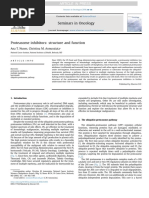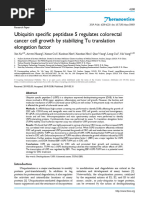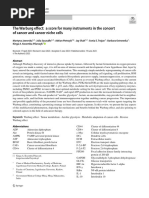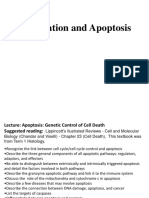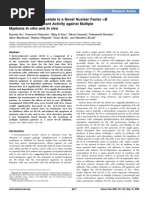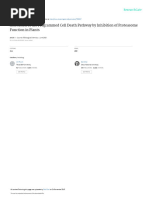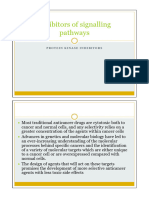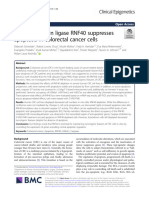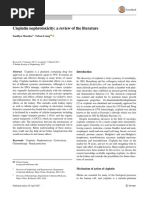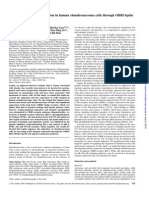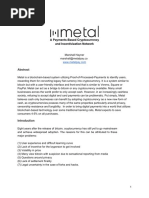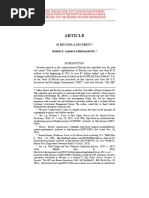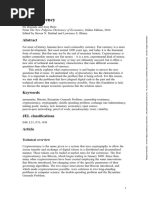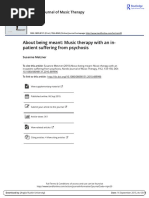Anti Cancer Constituents Lei Gong Teng Etc
Anti Cancer Constituents Lei Gong Teng Etc
Uploaded by
nepretipCopyright:
Available Formats
Anti Cancer Constituents Lei Gong Teng Etc
Anti Cancer Constituents Lei Gong Teng Etc
Uploaded by
nepretipCopyright
Available Formats
Share this document
Did you find this document useful?
Is this content inappropriate?
Copyright:
Available Formats
Anti Cancer Constituents Lei Gong Teng Etc
Anti Cancer Constituents Lei Gong Teng Etc
Uploaded by
nepretipCopyright:
Available Formats
NIH Public Access
Author Manuscript
Curr Drug Discov Technol. Author manuscript; available in PMC 2012 March 16.
NIH-PA Author Manuscript
Published in final edited form as:
Curr Drug Discov Technol. 2010 March 1; 7(1): 4653.
Targeting Tumor Proteasome with Traditional Chinese Medicine
Huanjie Yang1, Jinbao Liu2, and Q. Ping Dou1,2,*
1The Prevention Program, Barbara Ann Karmanos Cancer Institute, and Department of
Pathology, School of Medicine, Wayne State University, Detroit, Michigan 48201, USA
2Department
of Pathophysiology, Guangzhou Medical College, Guangzhou, Guangdong,
Peoples Republic of China
Abstract
NIH-PA Author Manuscript
The proteasome is a multicatalytic protease complex whose activity is required for the growth of
normal or tumor cells. It has been shown that human cancer cells are more sensitive to proteasome
inhibition than normal cells, indicating that the proteasome could be a target of chemotherapy.
Studies suggest that traditional Chinese medicine (TCM) is an effective approach for cancer
treatment. Here we reviewed several TCMs for their potential in treatment of cancer. This short
review focuses mainly on the TCMs that potentially target the tumor cellular proteasome and NFB pathway whose activation is dependent on the proteasome activity.
Keywords
Proteasome inhibitors; natural products; medicinal compounds; cancer; prevention; treatment
1. INTRODUCTION
NIH-PA Author Manuscript
The use of traditional Chinese medicine (TCM) for medicinal applications has a long and
distinguished track record. Dating back to 1500s, Li Shizhen, one of the greatest physicians
and pharmacologists in Chinese history described more than one thousand herbs and their
application toward the treatment of diseases. TCM continues to be practiced worldwide, and
its continued impact on human health and disease may serve as a useful model for modern
drug discovery. Achieving a better understanding of the mechanisms of these antiquated
medicines may help expedite their use in the clinical setting. Here we attempted to discuss
the role of several TCMs in the treatment of human cancer, with special emphasis on tumor
cellular proteasome and NF-kappaB (NF-B) as putative molecular targets; however we
sincerely apologize to those authors whose work has not been cited in this short review
because of space limitation.
2. CANCER, UBIQUITIN-PROTEASOME SYSTEM AND NF-B PATHWAY
The ubiqutin-proteasome pathway is responsible for the timely degradation of most
intercellular proteins. First, the targeted protein is marked with a chain of small polypeptides
called ubiquitin. Ubiquitination is mediated by a series of enzymes, called E1 ubiquitin
activating enzyme, E2 ubiquitin-conjugating enzyme and E3 ubiquitin-ligating enzyme [1].
Ubiquitin is activated by E1 ubiquitin enzyme through adenylation and formation of high-
2010 Bentham Science Publishers Ltd.
*
Address corresponding to this author at the Barbara Ann Karmanos Cancer Institute, and Department of Pathology, School of
Medicine, Wayne State University, 540.1 HWCRC, 4100 John R. Road, Detroit, Michigan 48201, USA; Tel: 313-576-8301; Fax:
313-576-8307; doup@karmanos.org.
Yang et al.
Page 2
NIH-PA Author Manuscript
energy thiol ester bond, and then linked to ubiquitin-conjugating enzyme E2 in an ATPdependent manner. The E3 ubiquitin ligase links the ubiquitin molecule to a reactive lysine
residue of a target protein [2]. These polyubiquitinated proteins can then be recognized and
targeted by the proteasome for degradation.
The proteasome is a large proteolytic complex with a molecular weight of ~2400 kDa. The
proteasome is often referred to as the 26S proteasome, and is expressed in both the nucleus
and the cytoplasm in all eukaryotic cells. It consists of one or two 19S regulatory particles
and a 20S catalytic core. The 20S proteasome consists of four stacked rings: two inner beta
rings and two outer alpha rings, each of which consists of seven subunits [3].
The 19S particle (700 kDa) consists of both a lid and a base, which is responsible for
controlling the access of substrates into the 20S proteasome. Furthermore, the 19S particle is
responsible for unfolding and threading the ubiquitinated proteins into the catalytic site of
the 20S proteasome [4]. These diverse actions are fulfilled by multiple subcomplexes of the
19S regulatory particle. For example, in S. cerevisae, the base subcomplex usually contains
8 subunits and six of them are ATPases that provide ATP for protein substrate unfolding [5].
At least nine subunits composing the lid are non-ATPases that are important for 19S
assembly and deubiquitination of ubiquitinated proteasome target proteins [5].
NIH-PA Author Manuscript
The 20S proteasome hydrolyzes the target protein through three proteolytic activities,
caspase or peptidyl-glutamyl peptide-hydrolyzing (PGPH)-like, trypsin-like and
chymotrypsin-like activities. These activities are mediated through three subunits, 1
(PGPH-like), 2 (trypsin-like), and 5 (chymotrypsin-like), respectively [6]. In accordance
with enzymes with similar hydrolytic activities, the 1 subunit cuts peptides after acidic
residues, the 2 subunit prefers to cleave after basic amino acids, and the 5 subunit
hydrolyzes after hydrophobic residues. All the three proteolytic activities depend on the
presence of the threonine residue at the amino terminal (Thr1) [7].
The higher level of proteasome activity was observed in tumor cells compared to normal
cells, suggesting the importance of the proteasome in the tumor growth. Indeed, several
antiapoptotic signaling pathways require proteasomal activity for their function. This is
especially true for the pro-oncogenic NF-B pathway. NF-B plays an important role in
tumorigenesis via transactivation of genes involved in cell proliferation, apoptosis, tumor
cell invasion, metastasis, and angiogenesis [8]. Constitutive activation of NF-B is
commonly observed in many types of cancer [8].
NIH-PA Author Manuscript
Five members, that are p65 (RelA), RelB, c-Rel, p50, and p52 subunits, have been identified
in the NF-B family, all of which contain a REL-homology domain that is responsible for
DNA binding, dimerization, nuclear translocation and endogenous inhibitor of NF-B (IB)
binding [9]. They form homo- and heterodimers through combinatorial assembly, but p50
and p52 must dimerize with a transactivation domain-containing member such as p65, cREL or REL-B to activate gene transcription [10]. The classic form of NF-B is p50/p65
heterodimer. The p50 and p52 subunits are processed from their precursors, p105 and p100,
respectively, through ubiquitin-dependent proteasome degradation pathway. IB bind to the
REL-homology domain of NF-B through ankyrin repeats, covering the nuclear localization
sequence of NF-B [9]. Therefore NF-B is normally sequestered in the cytoplasm through
association with its endogenous inhibitor IB.
Upon stimulation, IB- is rapidly phosphorylated by kinase IKK (IB kinase) composed of
two catalytic subunits, IKK- and IKK-, and one regulatory subunit IKK- [11].
Phosphorylated IB- is specifically recognized by SCF-TrCP ubiquitin ligase at the 19amino-acid destruction motif in residues 21-41 [12] and transferred to the proteasome for
degradation while NF-B is allowed to be translocated to the nucleus and mediate
Curr Drug Discov Technol. Author manuscript; available in PMC 2012 March 16.
Yang et al.
Page 3
NIH-PA Author Manuscript
transcription of anti-apoptotic genes. However, accumulation of the IB- protein via
proteasome inhibition prevents the activation of anti-apoptotic NF-B [13], resulting in
tumor growth inhibition and/or apoptosis.
Patients with multiple myeloma (MM) have elevated circulating proteasome, supporting the
idea of targeting the proteasome for MM therapy [14]. Bortezomib is the first proteasome
inhibitor that entered clinical trials and has been extensively investigated in MM [15].
Remarkable efficacy of bortezomib as a single agent or in combination with other
chemotherapeutic drugs was observed in newly diagnosed or refractory myeloma patients.
Bortezomib also demonstrated effectiveness against lymphoma [15]. Due to the space limit
of this succinct review, we can not refer extensive literature on this topic and we sincerely
apologize to those authors whose work has not been cited here.
3. LEI GONG TENG (THUNDER GOD VINE)
NIH-PA Author Manuscript
Lei gong teng (Thunder God Vine) is ivy like shrub, named Tripterygium wilfordii Hook F,
belonging to the family Celastraceae. It is indigenous to southern China and has been used
as folk medicine for autoimmune and inflammatory diseases over centuries [16]. This
creeping plant is also called Seven-step vine, indicating the high toxicity. Indeed, although
most of the active components are isolated from the root of the plant [17], ingestion of
leaves, flowers, or even the pollens is capable of causing death [18]. Triterpenes and
diterpenes and a number of other bioactive compounds have been isolated from lei gong
teng Lei Gong Teng [19]. Most research was conduced with triptolide and celastrol, the two
major components of lei gong teng.
3.1. Triptolide
Triptolide is predominantly extracted from the tender root of lei gong teng [17]. Triptolide
(PG490) is a diterpene triepoxide (Fig. 1), which is highly oxygenated at the 7,8; 9,11; and
12,13 positions of epoxides. The hydrogen-bonded 9,11-epoxy-14-beta-hydroxy system may
be involved in triptolides antineoplastic activity [20]. A study using a 3H-labeled triptolide
showed that triptolide binding was saturable, reversible, and primarily localized to cell
membranes [21]. It inhibited cell growth at low concentrations and induced apoptosis at high
concentrations [22]. Triptolide has not been shown to act as an inhibitor of the proteasome,
but several reports demonstrated that it affected the NF-B pathway, whose activation is
highly dependent on the ubiquitin-proteasome pathway.
NIH-PA Author Manuscript
Triptolide inhibited transactivation of NF-B induced by Tumor Necrosis Factor- (TNF-)
and further blocked NF-B-mediated induction of the inhibitor of apoptosis c- Inhibitor of
Apoptosis Protein 1 (IAP1) and c-IAP2 [23]. Trip-tolide inhibited NF-B transactivation
without inhibiting nuclear NF-B DNA binding activity [23, 24] or even with increased
nuclear NF-B DNA binding activity [25]. Further study demonstrated that triptolide
inhibited the binding of p65 to transcriptional coactivator CBP/p300 [26]. Triptolide also
suppressed the phorbol myristyl acetate (PMA)-induced activation of NF-B, in turn,
inhibited the overexpression of urokinase-type plasminogen activator receptor (uPAR),
which is required for tumor cell invasion [27]. In addition, Triptolide inhibited up to 80%
mRNA de novo synthesis in various tumor cells by inhibiting RNA polymerase I and II [28],
indicating that it hits a wide spectrum of targets.
F60008 is a semi-synthetic derivative of triptolide that is highly water soluble, and acts as a
prodrug of triptolide. F60008 is converted to triptolide in vivo following intravenous
administration. A phase I and pharmacological trial was conducted using F60008 given
intravenously as a weekly infusion for 2 weeks every 3 weeks in patients with advanced
solid tumors. F60008 was converted into triptolide, but the conversion was not complete.
Curr Drug Discov Technol. Author manuscript; available in PMC 2012 March 16.
Yang et al.
Page 4
NIH-PA Author Manuscript
Two patients encountered lethal side effects. High inter-individual variability was observed
[29]. All these suggested that F60008 was not an optimal derivative of triptolide for clinical
use.
3.2. Celastrol
NIH-PA Author Manuscript
Celastrol is a quinone methide triterpene (Fig. 1) isolated from lei gong teng. It is also
extracted from Tripterygium regeli, a substitute of lei gong teng found in northeast of China
[30]. We have predicted that celastrol is a proteasome inhibitor by molecular modeling and
later confirmed its proteasome-inhibitory activity by in vitro and in vivo experiments [31].
Analysis of atomic orbital energy on celastrol showed that C2 on A-ring and C6 on B-ring of
celastrol had a high susceptibility toward a nucleophilic attack. Celastrol could be docked
into the S1 pocket of 5 subunit of the proteasome in a conformation to interact with Thr1,
the active site of 5 subunit at 92% possibility. To provide direct evidence for proteasome
inhibition by celastrol, we performed a cell-free proteasome activity assay using a purified
rabbit 20S proteasome in the presence of celastrol at various concentrations. Celastrol
potently and preferentially inhibits the chymotrypsin-like activity of a purified 20S
proteasome with an IC50 value 2.5 mol/L. In intact human prostate cancer cells, cellular
26S proteasome was inhibited by celastrol at 15 mol/L. The inhibition of the proteasome
activity by celastrol results in accumulation of ubiquitinated proteins and three natural
proteasome substrates (IB-, Bax and p27), and induction of apoptosis in androgen
receptor-positive or androgen receptor-negative prostate cancer cells. Treatment of human
prostate tumor-bearing nude mice with celastrol (13 mg/kg/day, i.p., for 1 to 31 days)
resulted in significant inhibition (6593%) of the tumor growth. Multiple assays using the
animal tumor tissue samples from both early and end time-points demonstrated in vivo
inhibition of the proteasomal activity and induction of apoptosis after celastrol treatment.
These results demonstrate that celastrol is a natural proteasome inhibitor that has a great
potential to be used for cancer prevention and treatment [31].
NIH-PA Author Manuscript
Antitumor activity of celastrol was also observed in other types of cancer. Celastrol
inhibited ~ 60% tumor growth in breast cancer xenograft through NF-B inhibition [32].
The NF-B inhibition by celastrol includes inhibition of its DNA-binding activity and
inhibition of proteasome-mediated IB- degradation which was induced by TNF- or
phorbol myristyl acetate (PMA) [32]. Further investigation showed that celastrol suppressed
the NF-B activation by targeting cysteine 179 in the IB- kinase (IKK) [32]. Celastrol
was able to potentiate apoptotic effects induced by TNF and chemotherapeutic agents, both
regulated by NF-B activation. It suppressed both inducible and constitutive NF-B
activation. Celastrol was also found to inhibit the TNF-induced activation of IB- kinase,
IB- phosphorylation, IB- degradation, p65 nuclear translocation and phosphorylation,
and NF-B-mediated reporter gene expression. TNF induced the expression of gene
products involved in anti-apoptosis, proliferation, invasion, and angiogenesis and that
celastrol treatment suppressed their expression [33].
Inhibition of NF-B was observed in concurrence with of activation of heat shock response,
indicating a potential link between the two pathways [34]. Indeed, celastrol induced
activation of Hsp70, Hsp40 and Hsp27, which was similar as observed in heat shock
treatment [34]. Up-regulation of Hsp70A is a well established cell response to Hsp90
inhibition [35]. Two groups independently reported that celastrol is an inhibitor of Hsp90
[36]. Both groups confirmed that celastrol is different with classic Hsp90 inhibitor such as
geldanamycin. Hieronymus et al. reported that celastrol inhibits ATP-binding activity of
Hsp90 through mechanisms outside the N-terminal ATP-binding pocket of Hsp90 [36] while
Zhang et al. reported that celastrol did not interfere with ATP binding to Hsp90 [37]. The
difference might be from the different experimental conditions. Celastrol disrupted the
interaction between Hsp90 and its cochaperone such as Cdc37 or p23 [36, 37]. Inhibition of
Curr Drug Discov Technol. Author manuscript; available in PMC 2012 March 16.
Yang et al.
Page 5
NIH-PA Author Manuscript
Hsp90 by celastrol resulted in suppression of its client proteins that play an important role in
tumor initiation and progression. Celastrol also suppressed androgen receptor (AR) that
mediates signaling important for prostate cancer progression [36]. The aryl hydrocarbon
receptor (AhR) is a client protein of Hsp 90, which plays a significant role in polycyclic
aromatic hydrocarbon (PAH)-induced carcinogenesis. Celastrol suppressed AhR expression,
resulting in decreased transctivation of CYP1A1 and CYP1B1, both of which encode proteins
that convert PAH to genotoxic metabolites [38]. Celastrol also inhibited antiangiogenesis by
suppressing vascular endothelial growth factor (VEGF) receptors expression [39].
4. FEN BEI NAN SHE TENG [CELASTRUS HYPOLEUCUS (OLIV) WARB F
ARGUTIOR LOES]
Fen bei nan she teng or Celastrus hypoleucus (Oliv) Warb f argutior Loes is another genus
that belongs to Celastraceae family. It is widely distributed in China and has been used in
the treatment of inflammation and detumescence. Celastrol and methyl celastrol, prestimerin
were isolated from this plant [40]. They are also found in other plants of the Celastraceae
family that are well distributed throughout tropical America [41].
NIH-PA Author Manuscript
Pristimerin is a natural analog of celastrol (Fig. 1). Not surprisingly, it also targets the
proteasome [42]. Nucleophilic susceptibility and in silico docking studies show that C6 of
pristimerin is highly susceptible towards a nucleophilic attack by the hydroxyl group of Thr1
of the proteasomal chymotrypsin subunit. Consistently, pristimerin potently inhibits the
chymotrypsin-like activity of a purified rabbit 20S proteasome (IC50 2.2 mol/L) and human
prostate cancer 26S proteasome (IC50 3.0 mol/L). The accumulation of ubiquitinated
proteins and three proteasome target proteins, Bax, p27 and IB-, in AR-negative PC-3
prostate cancer cells supports the conclusion that proteasome inhibition by pristimerin is
physiologically functional. This observed proteasome inhibition subsequently led to the
induction of apoptotic cell death in a dose- and kinetic-dependent manner. Furthermore, in
AR-positive, androgen-dependent LNCaP and AR-positive, androgen-independent C4-2B
prostate cancer cells, proteasome inhibition by pristimerin results in suppression of AR
protein prior to apoptosis. These data demonstrate that the proteasome is a target of
pristimerin in prostate cancer cells and inhibition of the proteasomal chymotrypsin-like
activity by pristimerin is responsible for its cancer cell death-inducing properties [42].
Inhibition of the chymotryptic activity of the proteasome by pristimerin was confirmed by
another group [43].
NIH-PA Author Manuscript
Currently, it is still not completely clear how pritimerin induces proteasome inhibition and
apoptosis. Pristimerin-triggered caspase activation was confirmed in human breast cancer
cells [44]. MDA-MB-231 cells treated with pristimerin showed rapid induction of apoptosis
through caspase activation, which could be completely prevented by pre-treatment with a
pancaspase inhibitor benzyloxycarbonyl-Val-Ala-Asp-fluoromethyl ketone (z-VAD-fmk).
Treatment of breast tumor cells with pristimerin resulted in a rapid release of cytochrome c
from mitochondria, which preceded caspase activation and the decrease of mitochondrial
membrane potential. This process did not depend on Bcl-2 family (Bcl-2, Bcl-XL and Bax)
protein levels and did not require translocation of Bax to the mitochondria. Moreover, the
generation of reactive oxygen species (ROS) in MDA-MB-231 cells was also not affected
by pristimerin [44]. However, pristimerin-induced mitochondrial cell death in cervical
cancer cells was reported through ROS generation [45]. It activated JNK and PARP-1
pathways, resulting loss of mitochondrial membrane potential, and apoptotic cell death. JNK
phosphorylation caused Bax mitochondrial translocation, cytochrome c release and caspase
3 or 9 activation. Using NAC to inhibit ROS generation prevents pristimerin-induced cell
death involved in both pathways [45].
Curr Drug Discov Technol. Author manuscript; available in PMC 2012 March 16.
Yang et al.
Page 6
5. ZI CAO (PURPLE GROMWELL)
NIH-PA Author Manuscript
Zi cao or purple gromwell is the dried root of Lithospermum erythrorhizon Sieb. et Zucc,
Arnebia euchroma (Royle) Johnst, or Arnebia guttata Bunge. It is a commonly used herbal
medicine in China and other countries [46]. Dating back to the 5th century, zi cao had been
used for the treatment of throat sore, burns, cut and skin diseases such as macular eruption,
measles and carbuncles in China [47].
NIH-PA Author Manuscript
Naphthoquinone shikonin (Fig. 1) is a main component isolated from zi cao. Our
computational modeling predicts that the carbonyl carbons C1 and C4 of shikonin potentially
interact with the catalytic site of 5 chymotryptic subunit of the proteasome [48]. Indeed,
shikonin potently inhibits the chymotrypsin-like activity of purified 20S proteasome (IC50
12.5 mol/L) and tumor cellular 26S proteasome (IC50 between 216 mol/L). Inhibition of
the proteasome by shikonin in murine hepatoma H22, leukemia P388 and human prostate
cancer PC-3 cultures resulted in accumulation of ubiquitinated proteins and several
proteasome target proapoptotic proteins (IB-, Bax and p27), followed by induction of cell
death. Shikonin treatment resulted in tumor growth inhibition in both H22 allografts and
PC-3 xenografts, associated with suppression of the proteasomal activity and induction of
cell death in vivo. Finally, shikonin treatment significantly prolonged the survival period of
mice bearing P388 leukemia. These results indicate that the tumor proteasome is one of the
cellular targets of shikonin and inhibition of the proteasome activity by shikonin contributes
to its antitumor properties [48].
Other studies revealed that shikonin induced different modes of cell death depending on the
concentrations applied [49]. In leukemia cell line HL60, shikonin induced a dominant
apoptosis at 2.5 M, a dominant necroptosis 10 M, and a mixed type at 5 M. When
HL60 cells were treated with shikonin (10 M) in the presence of Nec-1, an specific
necroptosis inhibitor, necroptosis was switched to apoptosis [49]. The death mode switch
was at least partially due to the conversion from mitochondrial inner membrane permeability
to outer membrane permeability [49]. In some drug-resistant tumor cell lines, such as
MCF-7 and HEK293 that overexpressed P-gp, Bcl-2 or Bcl-XL, shikonin induced a
dominant necroptosis, which could circumvent cancer drug resistance [50]. Shiikonin also
down-regulated expression of steroid sulfatase mRNA and decreased enzymatic activity in
breast cancer [51].
NIH-PA Author Manuscript
So far, only one clinical trial using shikonin-containing mixture was found in the literature.
In 19 cases of late-stage lung cancer that were not suitable for surgery and irradiation, a
shikonin-containing mixture reduced tumor diameter radiographically in 63.3% of patients,
with a reported remission rate of 36.9%, and 1-year survival rate of 47.3% [52].
Furthermore, administration of the shikonin-containing mixture increased body weight and
appetite of patients. No harmful effects on the peripheral system, heart, kidney and liver
were observed after shikonin treatment [52].
6. JIANGHUANG (TUMERIC)
Spice tumeric (Curcuma logma Linn) has been used in China, India and Southeast Asia for
centuries as food coloring and flavoring agent. In addition, it has a well-documented history
in medicine in China and India [53]. Tumeric is used to treat various diseases, including
respiratory conditions, inflammation, liver disorders, diabetic wounds, cough, and certain
tumors [54].
Curcumin (diferuloylmethane) (Fig. 1) is the yellow pigment derived from the rhizome of
Curcuma longa. It inhibits tumor cell proliferation, invasion, angiogenesis and metastasis,
involved in multiple cellular targets [55]. The tumor cellular proteasome is most likely one
Curr Drug Discov Technol. Author manuscript; available in PMC 2012 March 16.
Yang et al.
Page 7
NIH-PA Author Manuscript
of important targets of curcumin. Nucleophilic susceptibility and in silico docking studies
show that both carbonyl carbons of the curcumin molecule are highly susceptible to a
nucleophilic attack by the hydroxyl group of the N-terminal threonine of the proteasomal
chymotrypsin-like subunit [56]. Curcumin could inhibit all three proteasomal activities but
with the highest potency to the chymotrypsin-like activity. Furthermore, inhibition of
proteasome activity by curcumin in human colon cancer HCT-116 and SW480 cell lines
leads to accumulation of ubiquitinated proteins and several proteasome target proteins, and
subsequent induction of apoptosis. Finally, treatment of HCT-116 colon tumor-bearing ICR
SCID mice with curcumin resulted in decreased tumor growth, associated with proteasome
inhibition, proliferation suppression, and apoptosis induction in tumor tissues [56].
NIH-PA Author Manuscript
Many studies have shown that curcumin also targets the NF-B pathway. Curcumin
suppresses constitutive activation of NF-B which is often observed in leukemia cells such
as multiple myeloma, mantle cell lymphoma and Burkitts lymphoma [5759] and solid
tumors such as pancreatic cancer [60]. Curcumin also inhibits drug-induced NF-B
activation that is triggered by many currently used chemotherapeutic drugs. Paclitaxel
induced proteasome-mediated degradation of IB-, which led to activation of NF-B in
human MDA-MB-231 breast cancer cells. This process could be inhibited by curcumin, thus
resulting in enhanced efficacy of paclitaxel for inhibiting breast cancer growth in vitro and
in vivo [61]. Curcumin reduced gemcitabine-induced NF-B activation in cultured human
bladder cancer 253JBV cells and abolished the constitutive activation of NF-B in the tumor
tissue of orthotopic mouse model, suggesting that curcumin potentiates the effects of
gemictabine, possibly through the modulation of NF-B signaling pathway [62].
NIH-PA Author Manuscript
The major problems that limit the clinical applications of curcumin are its poor water
solubility and bioavailability. Indeed, curcumin exhibited poor bioavailability after oral
administration with low nanomolar levels of the parent compound and large amount of its
glucuronide and sulphate conjugates found in the peripheral or portal circulation [63, 64].
Chemotherapeutic effects of curcumin were observed in colon cancer. Administration of
curcumin-containing extract demonstrated radiologically stable disease in 5 out 15 patients
for 24 months [65]. A daily dose of 3.6 g curcumin could significantly decrease levels of
inducible Prostaglandin E2 (PGE2) production and DNA adduct M1G formed by
malondialdehyde, confirming that curcumin could be achieved at pharmacologically active
levels in the colorectum of humans [66, 67]. Trails to determine effects of curcumin against
other types of cancers were conducted, showing curcumin was not efficient against the
tumors distant from the locus of absorption [63]. Trials currently underway include an
evaluation of colon cancer patients treated with gemcitabine in combination with curcumin
and celecoxib (NCT00295035; Tel-Aviv Sourasky Medical Center) and pancreatic cancer
patients treated with curcumin combined with gemcitabine (NCT00192842; Rambam Health
Care Campus).
7. BU GU ZHI (PSORALEA CORYLIFOLIA L.)
Bu gu zhi, also called Psoralea corylifolia L. is a plant belonging to the Fabaceae family.
This plant has been used in Chinese and Indian traditional medicine for the treatment of
leukoderma, leprosy, psoriasis, vitiligo, and inflammatory diseases of the skin [68]. Recent
animal studies suggest it potential use to prevent brain aging [69].
More than 35 components have been isolated from bu gu zhi, such as psoralen, isopsoralen,
psoralidin, corylifolin, corylin, corylifolinin, isobavachalcone, corylifol A, and bakuchiol
[7073], which are abundant in the seed [73]. No monomer of Psoralea corylifolia L. has
been reported to target the proteasome, while the whole extract of this medicinal plant was
found to inhibit the proteasome [68]. Incubation of SH-SY5Y cells with 20 g/mL of
Curr Drug Discov Technol. Author manuscript; available in PMC 2012 March 16.
Yang et al.
Page 8
NIH-PA Author Manuscript
Psoralea corylifolia for 24 h significantly inhibited all the three proteasome activities to a
similar level (about 20% lower compared to control). Accumulation of poly-ubiquitinated
proteins was observed in Psoralea corylifolia extract-treated SH-SY5Y cells, supporting the
inhibition of proteasome activities by Psoralea corylifolia [68]. In addition, bakuchiol (Fig.
1), one monomer of Psoralea corylifolia was found to inhibit NF-B binding activity that
was induced by pro-inflammatory cytokines, interferon and lipopolysaccharide (LPS) [74].
8. ORCHID DENDROBIUM LODDIGESII ROLFE
Dendrobium loddigesii Rolfe has been commonly used in traditional Chinese medicine as a
tonic to nourish the stomach, replenish body fluid, and reduce fever [75]. Dendrophenol
(4,4-dihydroxy-3,3,5-trimethoxybibenzyl), also named Moscatilin (Fig. 1) was isolated
from the stem of Dendrobium loddigesii Rolfe [76] and was shown to act as a NF-B
inhibitor [77]. It inhibited phosphorylation of IB-, suppressed nuclear translocation of NFB subunits, p65 and p50, and NF-B activity. Mosatilin also showed antiproliferative
effects against a panel of tumor cell lines including liver, lung and stomach cancers [75].
Moscatilin induced apoptosis in colon cancer HCT 116 cells through tubulin
depolymerization and DNA damage stress, which lead to JNK activation and mitochondriainvolved apoptosis [78], suggesting the potential clinical anticancer application of
moscatilin.
NIH-PA Author Manuscript
CONCLUSION
In this review we attempted to focus mainly on the TCMs that potentially target the tumor
cellular proteasome and NF-B pathway. Medicinal plants have been used as folk medicines
in China for over centuries. Separation techniques allowed researchers to analyze monomer
component or purified compounds from the plant extract of TCM. Development on
molecular biology allowed researchers to dissect the complex network which aberrant lead
to malfunction of normal cell or cancer. To better understand how TCM hit the cellular
targets for disease treatment, scientists tried to identify the molecules that are involved in the
action of TCM.
NIH-PA Author Manuscript
In tumor cells, high level of the proteasome activity is often observed, suggesting that the
proteasome is essential in tumor growth. Indeed, the proteasome is required for NF-B
activation which is required for cell proliferation, tumor cell invasion, metastasis, and
angiogenesis. The first proteasome inhibitor Bortezomib has been tested in clinical trials for
several years and significant efficacies against multiple myeloma have been reported in
different setting of trials. The results in some cases have been impressive. There is less
evidence of botezomibs efficacy against solid tumors. There is therefore interest in
developing the natural proteasome inhibitors from TCMs. Whether TCM target the
proteasome and/or NF-B pathway has been investigated by using TCM pure monomers or
isolated compounds. Isolated celastrol, shikonin and curcumin have been shown to inhibit
purified 20S proteasome and 26S proteasome in cultured tumor cells and tumor tissues.
Triptolide, celastrol and moscatilin have also been shown to suppress NF-B pathway. They
inhibited IB- degradation, nuclear translocation of NF-B subunits p65 and p50, and NFB binding activity. These properties entitle these TCM compounds with ability to suppress
tumor growth. Future studies should focus on the molecularly targeted clinical trails using
TCMs.
Acknowledgments
The research was partially supported by grants from National Cancer Institute (1R01CA120009 and
3R01CA120009-04S1 to Q.P. Dou) and a grant from The National High Technology Research and Development
Curr Drug Discov Technol. Author manuscript; available in PMC 2012 March 16.
Yang et al.
Page 9
Program of China (2006AA02Z4B5 to J. Liu). The authors thank Mr. Michal Frezza for critical reading of the
manuscript.
NIH-PA Author Manuscript
ABBREVIATIONS
NIH-PA Author Manuscript
AR
Androgen receptor
AhR
Hydrocarbon receptor
EGFR
Epidermal growth factor receptor
IAP
Inhibitor of apoptosis protein
IB
Inhibitor of NF-B
LPS
Lipopolysaccharide
MM
Multiple myeloma
NF-B
Nuclear factor kappa B
PAH
Polycyclic aromatic hydrocarbon
PGPH
Peptidyl-glutamyl peptide-hydrolyzing-like
PMA
Phorbol myristyl acetate
PGE2
Prostaglandin E2
ROS
Reactive oxygen species
Thr1
The threonine residue at the amino terminal
TNF
Tumor necrosis factor
uPAR
Urokinase-type plasminogen activator receptor
VEGF
Vascular endothelial growth factor
References
NIH-PA Author Manuscript
1. Ciechanover A. The ubiquitin-proteasome proteolytic pathway. Cell. 1994; 79(1):1321. [PubMed:
7923371]
2. Ciechanover A. The ubiquitin-proteasome pathway: on protein death and cell life. EMBO J. 1998;
17(24):715160. [PubMed: 9857172]
3. Goldberg AL. Protein degradation and protection against misfolded or damaged proteins. Nature.
2003; 426(6968):89599. [PubMed: 14685250]
4. Dou QP, Smith DM, Daniel KG, Kazi A. Interruption of tumor cell cycle progression through
proteasome inhibition: implications for cancer therapy. Prog Cell Cycle Res. 2003; 5:4416.
[PubMed: 14593738]
5. Pickart CM, Cohen RE. Proteasomes and their kin: proteases in the machine age. Nat Rev Mol Cell
Biol. 2004; 5(3):17787. [PubMed: 14990998]
6. Orlowski RZ, Kuhn DJ. Proteasome inhibitors in cancer therapy: Lessons from the first decade. Clin
Cancer Res. 2008; 14(6):164957. [PubMed: 18347166]
7. Groll M, Ditzel L, Lowe J, et al. Structure of 20S proteasome from yeast at 2.4 A resolution. Nature.
1997; 386(6624):46371. [PubMed: 9087403]
8. Orlowski RZ, Baldwin AS Jr. NF-kappaB as a therapeutic target in cancer. Trends Mol Med. 2002;
8(8):3859. [PubMed: 12127724]
9. Baud V, Karin M. Is NF-kappaB a good target for cancer therapy? Hopes and pitfalls. Nat Rev Drug
Discov. 2009; 8(1):3340. [PubMed: 19116625]
10. Bhoj VG, Chen ZJ. Ubiquitylation in innate and adaptive immunity. Nature. 2009; 458(7237):430
37. [PubMed: 19325622]
Curr Drug Discov Technol. Author manuscript; available in PMC 2012 March 16.
Yang et al.
Page 10
NIH-PA Author Manuscript
NIH-PA Author Manuscript
NIH-PA Author Manuscript
11. Solt LA, May MJ. The IkappaB kinase complex: master regulator of NF-kappaB signaling.
Immunol Res. 2008; 42(13):318. [PubMed: 18626576]
12. Winston JT, Strack P, Beer-Romero P, Chu CY, Elledge SJ, Harper JW. The SCFbeta-TRCPubiquitin ligase complex associates specifically with phosphorylated destruction motifs in
IkappaBalpha and beta-catenin and stimulates IkappaBalpha ubiquitination in vitro. Genes Dev.
1999; 13(3):27083. [PubMed: 9990852]
13. Biswas DK, Iglehart JD. Linkage between EGFR family receptors and nuclear factor kappaB (NFkappaB) signaling in breast cancer. J Cell Physiol. 2006; 209(3):64552. [PubMed: 17001676]
14. Jakob C, Egerer K, Liebisch P, et al. Circulating proteasome levels are an independent prognostic
factor for survival in multiple myeloma. Blood. 2007; 109(5):21005. [PubMed: 17095627]
15. Yang H, Zonder JA, Dou QP. Clinical development of novel proteasome inhibitors for cancer
treatment. Expert Opin Investig Drugs. 2009; 18(7):95771.
16. Xu G, Tu W, Jiang D, Xu C. Tripterygium wilfordii Hook F treatment for idiopathic refractory
nephrotic syndrome in adults: A meta-analysis. Nephron. 2009; 111(4):c22328. [PubMed:
19287181]
17. Luo XL, Shao Q, Qu HB, Cheng YY. Simple method for determination of five terpenoids from
different parts of Tripterygium wilfordii and its preparations by HPLC coupled with evaporative
light scattering detection. J Sep Sci. 2007; 30(9):128491. [PubMed: 17623469]
18. Deng W. Analysis of the Toxicities and Side Effects of Leigongteng. Pharmacology and Clinics of
Chinese Materia Medica. 2001; 17(3):4247.
19. Zhou BN. Some progress on the chemistry of natural bioactive terpenoids from Chinese medicinal
plants. Mem Inst Oswaldo Cruz. 1991; 86(Suppl 2):21926. [PubMed: 1842005]
20. Kupchan SM, Schubert RM. Selective alkylation: A biomimetic reaction of the antileukemic
triptolides? Science. 1974; 185(153):7913. [PubMed: 4843378]
21. Leuenroth SJ, Crews CM. Studies on calcium dependence reveal multiple modes of action for
triptolide. Chem Biol. 2005; 12(12):125968. [PubMed: 16356843]
22. Kiviharju TM, Lecane PS, Sellers RG, Peehl DM. Antiproliferative and proapoptotic activities of
triptolide (PG490), a natural product entering clinical trials, on primary cultures of human
prostatic epithelial cells. Clin Cancer Res. 2002; 8(8):266674. [PubMed: 12171899]
23. Lee KY, Chang W, Qiu D, Kao PN, Rosen GD. PG490 (triptolide) cooperates with tumor necrosis
factor-alpha to induce apoptosis in tumor cells. J Biol Chem. 1999; 274(19):1345155. [PubMed:
10224110]
24. Jiang XH, Wong BC, Lin MC, et al. Functional p53 is required for triptolide-induced apoptosis and
AP-1 and nuclear factor-kappaB activation in gastric cancer cells. Oncogene. 2001; 20(55):8009
18. [PubMed: 11753684]
25. Qiu D, Zhao G, Aoki Y, et al. Immunosuppressant PG490 (triptolide) inhibits T-cell interleukin-2
expression at the level of purine-box/nuclear factor of activated T-cells and NF-kappaB
transcriptional activation. J Biol Chem. 1999; 274(19):1344350. [PubMed: 10224109]
26. Zhu W, Ou Y, Li Y, et al. A small-molecule triptolide suppresses angiogenesis and invasion of
human anaplastic thyroid carcinoma cells via down-regulation of the nuclear factor-kappa B
pathway. Mol Pharmacol. 2009; 75(4):8129. [PubMed: 19158360]
27. Chang HJ, Kim MH, Baek MK, et al. Triptolide inhibits tumor promoter-induced uPAR expression
via blocking NF-kappaB signaling in human gastric AGS cells. Anticancer Res. 2007; 27(5A):
341117. [PubMed: 17970088]
28. Vispe S, Devries L, Creancier L, et al. Triptolide is an inhibitor of RNA polymerase I and IIdependent transcription leading predominantly to down-regulation of short-lived mRNA. Mol
Cancer Ther. 2009; 8(10):278090. [PubMed: 19808979]
29. Kitzen JJ, de Jonge MJ, Lamers CH, et al. Phase I dose-escalation study of F60008, a novel
apoptosis inducer, in patients with advanced solid tumours. Eur J Cancer. 2009; 45(10):176472.
[PubMed: 19251409]
30. Chen D, Cui QC, Yang H, Dou QP. Disulfiram, a clinically used anti-alcoholism drug and copperbinding agent, induces apoptotic cell death in breast cancer cultures and xenografts via inhibition
of the proteasome activity. Cancer Res. 2006; 66(21):1042533. [PubMed: 17079463]
Curr Drug Discov Technol. Author manuscript; available in PMC 2012 March 16.
Yang et al.
Page 11
NIH-PA Author Manuscript
NIH-PA Author Manuscript
NIH-PA Author Manuscript
31. Yang H, Chen D, Cui QC, Yuan X, Dou QP. Celastrol, a triterpene extracted from the Chinese
Thunder of God Vine, is a potent proteasome inhibitor and suppresses human prostate cancer
growth in nude mice. Cancer Res. 2006; 66(9):475865. [PubMed: 16651429]
32. Lee JH, Koo TH, Yoon H, et al. Inhibition of NF-kappa B activation through targeting I kappa B
kinase by celastrol, a quinone methide triterpenoid. Biochem Pharmacol. 2006; 72(10):131121.
[PubMed: 16984800]
33. Sethi G, Ahn KS, Pandey MK, Aggarwal BB. Celastrol, a novel triterpene, potentiates TNFinduced apoptosis and suppresses invasion of tumor cells by inhibiting NF-kappaB-regulated gene
products and TAK1-mediated NF-kappaB activation. Blood. 2007; 109(7):272735. [PubMed:
17110449]
34. Westerheide SD, Bosman JD, Mbadugha BN, et al. Celastrols as inducers of the heat shock
response and cytoprotection. J Biol Chem. 2004; 279(53):5605360. [PubMed: 15509580]
35. Cullinan SB, Whitesell L. Heat shock protein 90: A unique chemotherapeutic target. Semin Oncol.
2006; 33(4):45765. [PubMed: 16890800]
36. Hieronymus H, Lamb J, Ross KN, et al. Gene expression signature-based chemical genomic
prediction identifies a novel class of HSP90 pathway modulators. Cancer Cell. 2006; 10(4):321
30. [PubMed: 17010675]
37. Zhang T, Hamza A, Cao X, et al. A novel Hsp90 inhibitor to disrupt Hsp90/Cdc37 complex against
pancreatic cancer cells. Mol Cancer Ther. 2008; 7(1):16270. [PubMed: 18202019]
38. Hughes D, Guttenplan JB, Marcus CB, Subbaramaiah K, Dannenberg AJ. Heat shock protein 90
inhibitors suppress aryl hydrocarbon receptor-mediated activation of CYP1A1 and CYP1B1
transcription and DNA adduct formation. Cancer Prev Res. 2008; 1(6):48593.
39. Huang Y, Zhou Y, Fan Y, Zhou D. Celastrol inhibits the growth of human glioma xenografts in
nude mice through suppressing VEGFR expression. Cancer Lett. 2008; 264(1):1016. [PubMed:
18343027]
40. Luo DQ, Wang H, Tian X, Shao HJ, Liu JK. Antifungal properties of pristimerin and celastrol
isolated from Celastrus hypoleucus. Pest Manag Sci. 2005; 61(1):8590. [PubMed: 15593077]
41. Buffa Filho W, Corsino J, Bolzani da SV, Furlan M, Pereira AM, Franca SC. Quantitative
determination for cytotoxic Friedo-noroleanane derivatives from five morphological types of
Maytenus ilicifolia (Celastraceae) by reverse-phase high-performance liquid chromatography.
Phytochem Anal. 2002; 13(2):758. [PubMed: 12018026]
42. Yang H, Landis-Piwowar KR, Lu D, et al. Pristimerin induces apoptosis by targeting the
proteasome in prostate cancer cells. J Cell Biochem. 2008; 103(1):23444. [PubMed: 17541980]
43. Tiedemann RE, Schmidt J, Keats JJ, et al. Identification of a potent natural triterpenoid inhibitor of
proteosome chymotrypsin-like activity and NF-kappaB with antimyeloma activity in vitro and in
vivo. Blood. 2009; 113(17):402737. [PubMed: 19096011]
44. Wu CC, Chan ML, Chen WY, Tsai CY, Chang FR, Wu YC. Pristimerin induces caspasedependent apoptosis in MDA-MB-231 cells via direct effects on mitochondria. Mol Cancer Ther.
2005; 4(8):127785. [PubMed: 16093444]
45. Byun JY, Kim MJ, Eum DY, et al. Reactive oxygen species-dependent activation of Bax and
PARP-1 is required for mitochondrial cell death induced by triterpenoid pristimerin in human
cervical cancer cells. Mol Pharmacol. 2009; 76(4):73444. [PubMed: 19574249]
46. Chen X, Yang L, Zhang N, et al. Shikonin, a component of chinese herbal medicine, inhibits
chemokine receptor function and suppresses human immunodeficiency virus type 1. Antimicrob
Agents Chemother. 2003; 47(9):281016. [PubMed: 12936978]
47. Chen X, Yang L, Oppenheim JJ, Howard MZ. Cellular pharmacology studies of shikonin
derivatives. Phytother Res. 2002; 16(3):199209. [PubMed: 12164262]
48. Yang H, Zhou P, Huang H, et al. Shikonin exerts antitumor activity via proteasome inhibition and
cell death induction in vitro and in vivo. Intl J Cancer. 2009; 124(10):245059.
49. Han W, Xie J, Li L, Liu Z, Hu X. Necrostatin-1 reverts shikonin-induced necroptosis to apoptosis.
Apoptosis. 2009; 14(5):67486. [PubMed: 19288276]
50. Han W, Li L, Qiu S, et al. Shikonin circumvents cancer drug resistance by induction of a
necroptotic death. Mol Cancer Ther. 2007; 6(5):16419. [PubMed: 17513612]
Curr Drug Discov Technol. Author manuscript; available in PMC 2012 March 16.
Yang et al.
Page 12
NIH-PA Author Manuscript
NIH-PA Author Manuscript
NIH-PA Author Manuscript
51. Zhang Y, Qian RQ, Li PP. Shikonin, an ingredient of Lithospermum erythrorhizon, down-regulates
the expression of steroid sulfatase genes in breast cancer cells. Cancer Lett. 2009; 284(1):4754.
[PubMed: 19419812]
52. Guo XP, Zhang XY, Zhang SD. Clinical trial on the effects of shikonin mixture on later stage lung
cancer. Zhong Xi Yi Jie He Za Zhi. 1991; 11(10):59899. 580. [PubMed: 1806305]
53. Hatcher H, Planalp R, Cho J, Torti FM, Torti SV. Curcumin: From ancient medicine to current
clinical trials. Cell Mol Life Sci. 2008; 65(11):163152. [PubMed: 18324353]
54. Aggarwal BB, Sung B. Pharmacological basis for the role of curcumin in chronic diseases: An ageold spice with modern targets. Trends Pharmacol Sci. 2009; 30(2):8594. [PubMed: 19110321]
55. Kunnumakkara AB, Anand P, Aggarwal BB. Curcumin inhibits proliferation, invasion,
angiogenesis and metastasis of different cancers through interaction with multiple cell signaling
proteins. Cancer Lett. 2008; 269(2):199225. [PubMed: 18479807]
56. Milacic V, Banerjee S, Landis-Piwowar KR, Sarkar FH, Majumdar AP, Dou QP. Curcumin
inhibits the proteasome activity in human colon cancer cells in vitro and in vivo. Cancer Res. 2008;
68(18):728392. [PubMed: 18794115]
57. Bharti AC, Shishodia S, Reuben JM, et al. Nuclear factor-kappaB and STAT3 are constitutively
active in CD138+ cells derived from multiple myeloma patients, and suppression of these
transcription factors leads to apoptosis. Blood. 2004; 103(8):317584. [PubMed: 15070700]
58. Hussain AR, Ahmed M, Al-Jomah NA, et al. Curcumin suppresses constitutive activation of
nuclear factor-kappa B and requires functional Bax to induce apoptosis in Burkitts lymphoma cell
lines. Mol Cancer Ther. 2008; 7(10):331829. [PubMed: 18852135]
59. Shishodia S, Amin HM, Lai R, Aggarwal BB. Curcumin (diferuloylmethane) inhibits constitutive
NF-kappaB activation, induces G1/S arrest, suppresses proliferation, and induces apoptosis in
mantle cell lymphoma. Biochem Pharmacol. 2005; 70(5):700713. [PubMed: 16023083]
60. Wang W, Abbruzzese JL, Evans DB, Larry L, Cleary KR, Chiao PJ. The nuclear factor-kappa B
RelA transcription factor is constitutively activated in human pancreatic adenocarcinoma cells.
Clin Cancer Res. 1999; 5(1):11927. [PubMed: 9918209]
61. Kang HJ, Lee SH, Price JE, Kim LS. Curcumin suppresses the paclitaxel-induced nuclear factorkappaB in breast cancer cells and potentiates the growth inhibitory effect of paclitaxel in a breast
cancer nude mice model. Breast J. 2009; 15(3):2239. [PubMed: 19645775]
62. Tharakan ST, Inamoto T, Sung B, Aggarwal BB, Kamat AM. Curcumin potentiates the antitumor
effects of gemcitabine in an orthotopic model of human bladder cancer through suppression of
proliferative and angiogenic biomarkers. Biochem Parmacol. 2010; 79(2):21828.
63. Garcea G, Jones DJ, Singh R, et al. Detection of curcumin and its metabolites in hepatic tissue and
portal blood of patients following oral administration. Br J Cancer. 2004; 90(5):10115. [PubMed:
14997198]
64. Dhillon N, Aggarwal BB, Newman RA, et al. Phase II trial of curcumin in patients with advanced
pancreatic cancer. Clin Cancer Res. 2008; 14(14):449199. [PubMed: 18628464]
65. Sharma RA, McLelland HR, Hill KA, et al. Pharmacodynamic and pharmacokinetic study of oral
Curcuma extract in patients with colorectal cancer. Clin Cancer Res. 2001; 7(7):1894900.
[PubMed: 11448902]
66. Sharma RA, Euden SA, Platton SL, et al. Phase I clinical trial of oral curcumin: Biomarkers of
systemic activity and compliance. Clin Cancer Res. 2004; 10(20):684754. [PubMed: 15501961]
67. Garcea G, Berry DP, Jones DJ, et al. Consumption of the putative chemopreventive agent
curcumin by cancer patients: Assessment of curcumin levels in the colorectum and their
pharmacodynamic consequences. Cancer Epidemiol Biomarkers Prev. 2005; 14(1):12025.
[PubMed: 15668484]
68. Tang SY, Gruber J, Wong KP, Halliwell B. Psoralea corylifolia L. inhibits mitochondrial complex
I and proteasome activities in SH-SY5Y cells. Ann N Y Acad Sci. 2007; 1100:48696. [PubMed:
17460213]
69. Zhao G, Zheng XW, Qin GW, Gai Y, Jiang ZH, Guo LH. In vitro dopaminergic neuroprotective
and in vivo antiparkinsonian-like effects of Delta 3,2-hydroxybakuchiol isolated from Psoralea
corylifolia (L). Cell Mol Life Sci. 2009; 66(9):161729. [PubMed: 19322517]
Curr Drug Discov Technol. Author manuscript; available in PMC 2012 March 16.
Yang et al.
Page 13
NIH-PA Author Manuscript
NIH-PA Author Manuscript
70. Ji L, Xu Z. Review of constituents in fruits of Psoralea corylifolia L. Zhongguo Zhong Yao Za Zhi.
1995; 20(2):12022. 128. [PubMed: 7779275]
71. Yadava RN, Verma V. A new biologically active flavonol glycoside from Psoralea corylifolia
(Linn). J Asian Nat Prod Res. 2005; 7(4):67175. [PubMed: 16087643]
72. Chen B, Liu LL, Zhai ZX, Chen W, Fang HS, Wu YT. Determination of major components in
Psoralea corylifolia L. by using supercritical fluid extraction (SFE). Se Pu. 2000; 18(1):613.
[PubMed: 12541459]
73. Qiao CF, Han QB, Mo SF, et al. Psoralenoside and isopsoralenoside, two new benzofuran
glycosides from Psoralea corylifolia. Chem Pharm Bull. 2006; 54(5):714716. [PubMed:
16651775]
74. Pae HO, Cho H, Oh GS, et al. Bakuchiol from Psoralea corylifolia inhibits the expression of
inducible nitric oxide synthase gene via the inactivation of nuclear transcription factor-kappaB in
RAW 264.7 macrophages. Int Immunopharmacol. 2001; 1(910):184955. [PubMed: 11562076]
75. Ho CK, Chen CC. Moscatilin from the orchid Dendrobrium loddigesii is a potential anticancer
agent. Cancer Invest. 2003; 21(5):72936. [PubMed: 14628431]
76. Li MF, Hirata Y, Xu GJ, Niwa M, Wu HM. Studies on the chemical constituents of Dendrobium
loddigesii rolfe. Yao Xue Xue Bao. 1991; 26(4):307710. [PubMed: 1659772]
77. Liu YN, Pan SL, Peng CY, et al. Moscatilin repressed lipopolysaccaride-induced HIF-1alpha
accumulation and NF-kappaB activation in murine RAW264.7 cells. Shock. 2009 May 18.
78. Chen TH, Pan SL, Guh JH, et al. Moscatilin induces apoptosis in human colorectal cancer cells: a
crucial role of c-Jun NH2-terminal protein kinase activation caused by tubulin depolymerization
and DNA damage. Clin Cancer Res. 2008; 14(13):425058. [PubMed: 18594007]
NIH-PA Author Manuscript
Curr Drug Discov Technol. Author manuscript; available in PMC 2012 March 16.
Yang et al.
Page 14
NIH-PA Author Manuscript
NIH-PA Author Manuscript
Fig. (1).
Chemical structures of compounds isolated from TCMs.
NIH-PA Author Manuscript
Curr Drug Discov Technol. Author manuscript; available in PMC 2012 March 16.
You might also like
- Plab Mock TestsDocument17 pagesPlab Mock TestsMisbah ShahzadiNo ratings yet
- Cordycepin suppresses FGF9-induced MA-10 cell tumor formationDocument18 pagesCordycepin suppresses FGF9-induced MA-10 cell tumor formationChris KohNo ratings yet
- Advances in Indole-Containing Alkaloids As Potential Anticancer Agents by Regulating AutophagyDocument12 pagesAdvances in Indole-Containing Alkaloids As Potential Anticancer Agents by Regulating AutophagyBRAYAN MORENONo ratings yet
- LeptocarpinaDocument7 pagesLeptocarpinaJ Nicolas MJNo ratings yet
- J Seminoncol 2018 01 004Document4 pagesJ Seminoncol 2018 01 004Vo VũNo ratings yet
- Thno 33803Document13 pagesThno 33803xnny4m44bhNo ratings yet
- Book 2011Document102 pagesBook 2011fdsjklsdfxsdfsdfNo ratings yet
- s43440-023-00504-1Document15 pagess43440-023-00504-1satviknrwNo ratings yet
- Protoonkogen OnkogenDocument22 pagesProtoonkogen OnkogenkurniawanNo ratings yet
- Anti-In Ammatory and Anti-Tumor Activities of Parthenolide: An UpdateDocument18 pagesAnti-In Ammatory and Anti-Tumor Activities of Parthenolide: An UpdateIna SuciNo ratings yet
- Protein Aggregation in The Cell Nucleus: Structure, Function and TopologyDocument7 pagesProtein Aggregation in The Cell Nucleus: Structure, Function and TopologyJennifer CarpenterNo ratings yet
- 2007 Article 63Document5 pages2007 Article 63marcussiNo ratings yet
- MarinedrugsDocument20 pagesMarinedrugsreni vionitaNo ratings yet
- Nf-Κb-Modulated Mir-130A Targets Tnf-Α In Cervical Cancer CellsDocument14 pagesNf-Κb-Modulated Mir-130A Targets Tnf-Α In Cervical Cancer CellsMazhar HussainNo ratings yet
- J Pupt 2020 101941Document10 pagesJ Pupt 2020 101941leehongkaiNo ratings yet
- Review Article: Recent Advances in p53 Research and Cancer TreatmentDocument7 pagesReview Article: Recent Advances in p53 Research and Cancer TreatmentMrBuuNo ratings yet
- Doses of RPZ and InhDocument8 pagesDoses of RPZ and InhDeedee RenovaldiNo ratings yet
- L 18 Apoptosis CM Sp15Document32 pagesL 18 Apoptosis CM Sp15cactus life foreverNo ratings yet
- Journal 1Document8 pagesJournal 1Shuhaidah SalehinNo ratings yet
- Cazal Et Al 2010Document8 pagesCazal Et Al 2010Intan RahmayantiNo ratings yet
- ISL AnticancerigenoDocument11 pagesISL AnticancerigenodcristanchocNo ratings yet
- Activation of The Programmed Cell Death Pathway byDocument12 pagesActivation of The Programmed Cell Death Pathway byamlmahmoudgad124No ratings yet
- Inhibitors of Signalling PathwaysDocument18 pagesInhibitors of Signalling Pathwaysam55eer55No ratings yet
- Kelainan Onkologi: Semester 5 FK UnswagatiDocument22 pagesKelainan Onkologi: Semester 5 FK UnswagatiNovita Trilianty MagdalenaNo ratings yet
- Stemcell PDFDocument1 pageStemcell PDFmortezahNo ratings yet
- Fphar 13 1004520Document15 pagesFphar 13 1004520rkreid77No ratings yet
- Targeting NOX, INOS and COX-2 in in Ammatory Cells: Chemoprevention Using Food PhytochemicalsDocument7 pagesTargeting NOX, INOS and COX-2 in in Ammatory Cells: Chemoprevention Using Food PhytochemicalsLe Cong HuanNo ratings yet
- Life Sciences: Haocheng Ao, Haichun Li, Xiujuan Zhao, Bingqian Liu, Lin LuDocument15 pagesLife Sciences: Haocheng Ao, Haichun Li, Xiujuan Zhao, Bingqian Liu, Lin LuPaoloMafaldoNo ratings yet
- OncologyDocument22 pagesOncologyIhda ParidahNo ratings yet
- Role and Mechanisms of Mitophagy in Liver DiseasesDocument30 pagesRole and Mechanisms of Mitophagy in Liver DiseasescarolinaNo ratings yet
- Targeting Neddylation Pathway With MLN4924 (Pevonedistat) InducesDocument6 pagesTargeting Neddylation Pathway With MLN4924 (Pevonedistat) InducescarlakerengrNo ratings yet
- The E3 Ubiquitin Ligase RNF40 Suppresses Apoptosis in Colorectal Cancer CellsDocument13 pagesThe E3 Ubiquitin Ligase RNF40 Suppresses Apoptosis in Colorectal Cancer CellsmaxxgoulazianNo ratings yet
- Therapeutic Potential and Biological Applications of-PMCDocument26 pagesTherapeutic Potential and Biological Applications of-PMCHarendra ChunduruNo ratings yet
- Effect of Low Dose Quercetin and CancerDocument21 pagesEffect of Low Dose Quercetin and CancerMetcher Maa AkhiNo ratings yet
- Cell Communication and Signaling: Leptin and Adiponectin: New Players in The Field of Tumor Cell and Leukocyte MigrationDocument10 pagesCell Communication and Signaling: Leptin and Adiponectin: New Players in The Field of Tumor Cell and Leukocyte Migrationrima noviaNo ratings yet
- Mdpi2 AntioxidantsDocument14 pagesMdpi2 AntioxidantsKatarinaNo ratings yet
- Immunosuppression and Kidney TrnsplantDocument25 pagesImmunosuppression and Kidney TrnsplantAbdul QuyyumNo ratings yet
- CA A Cancer J Clinicians - May June 2005 - Ghobrial - Targeting Apoptosis Pathways in Cancer TherapyDocument17 pagesCA A Cancer J Clinicians - May June 2005 - Ghobrial - Targeting Apoptosis Pathways in Cancer Therapyonur ateşNo ratings yet
- Cisplatin Cause NephrotoxicityDocument11 pagesCisplatin Cause NephrotoxicityZiRong TsengNo ratings yet
- P-Glycoprotein: 1 FunctionDocument5 pagesP-Glycoprotein: 1 FunctionZiedTrikiNo ratings yet
- Journal CancerDocument17 pagesJournal CancerbeklogNo ratings yet
- Role of The Autotaxin-Lysophosphatidate Axis in Cancer Resistance To Chemotherapy and RadiotherapyDocument28 pagesRole of The Autotaxin-Lysophosphatidate Axis in Cancer Resistance To Chemotherapy and Radiotherapyxtang2No ratings yet
- Therapeutic Strategies of Targeting Non Apoptotic Regulated Cell Death (RCD) With Small Molecule Compounds in CancerDocument39 pagesTherapeutic Strategies of Targeting Non Apoptotic Regulated Cell Death (RCD) With Small Molecule Compounds in Cancerstefanpopovic1211No ratings yet
- Chen 2009Document11 pagesChen 2009darksoul4040940No ratings yet
- Molecular BiologyDocument44 pagesMolecular BiologyYasmin BalochNo ratings yet
- Leaflet Waspada DiareDocument10 pagesLeaflet Waspada DiareNikkiNo ratings yet
- 1953 FullDocument10 pages1953 FullboboyoyotNo ratings yet
- Cyclin Dependent Kinase As AnticancerDocument18 pagesCyclin Dependent Kinase As AnticancerLydia Angelia YanitaNo ratings yet
- A Free Radical Scavenger Ameliorates Teratogenic Activity of A DNA Hypomethylating Hematological TherapeuticDocument17 pagesA Free Radical Scavenger Ameliorates Teratogenic Activity of A DNA Hypomethylating Hematological TherapeuticMarta Himelreich PerićNo ratings yet
- CURCUMINpdfDocument7 pagesCURCUMINpdfDede MulyamanNo ratings yet
- IJCEP2017Document11 pagesIJCEP2017mirandeliNo ratings yet
- Research Article: Involvement of Prohibitin Upregulation in Abrin-Triggered ApoptosisDocument11 pagesResearch Article: Involvement of Prohibitin Upregulation in Abrin-Triggered ApoptosisAndri Praja SatriaNo ratings yet
- Molecules 28 01352 With CoverDocument21 pagesMolecules 28 01352 With CoveracheikhrouhouNo ratings yet
- Ars 2009 2816Document32 pagesArs 2009 2816Nilabh RanjanNo ratings yet
- 1 s2.0 S0753332216328062 MainDocument8 pages1 s2.0 S0753332216328062 Mainmeeret zerihunNo ratings yet
- Quercetin Alleviates Acute Kidney Injury by Inhibiting FerroptosisDocument13 pagesQuercetin Alleviates Acute Kidney Injury by Inhibiting Ferroptosisdiego.battiatoNo ratings yet
- Organelle-Specific Autophagy in Inflammatory Diseases A Potential Therapeutic Target Underlying The Quality Control of Multiple OrganellesDocument18 pagesOrganelle-Specific Autophagy in Inflammatory Diseases A Potential Therapeutic Target Underlying The Quality Control of Multiple OrganelleseNo ratings yet
- DAW22 natural coumarinDocument9 pagesDAW22 natural coumarinTony AbracadabraNo ratings yet
- Leptin 1Document9 pagesLeptin 1vestibuleNo ratings yet
- Wang 2017Document7 pagesWang 2017Danilo RosaNo ratings yet
- The Bitcoin Backbone Protocol: Analysis and ApplicationsDocument44 pagesThe Bitcoin Backbone Protocol: Analysis and ApplicationsnepretipNo ratings yet
- A Payments-Based Cryptocurrency and Incentivization NetworkDocument12 pagesA Payments-Based Cryptocurrency and Incentivization NetworknepretipNo ratings yet
- Bitcoins: Illegal Tender' or Currency of The Future?: Expert AnalysisDocument3 pagesBitcoins: Illegal Tender' or Currency of The Future?: Expert AnalysisnepretipNo ratings yet
- IRS Targets BitcoinDocument4 pagesIRS Targets BitcoinnepretipNo ratings yet
- Bitcoin Unlimited: Articles of FederationDocument12 pagesBitcoin Unlimited: Articles of FederationnepretipNo ratings yet
- 21.1 Alberts Final WebDocument21 pages21.1 Alberts Final WebnepretipNo ratings yet
- Bitcoin: Questions, Answers, and Analysis of Legal Issues: Edward V. MurphyDocument36 pagesBitcoin: Questions, Answers, and Analysis of Legal Issues: Edward V. MurphynepretipNo ratings yet
- 27HarvJLTech587 PDFDocument22 pages27HarvJLTech587 PDFnepretipNo ratings yet
- Cryptocurrency: Technical OverviewDocument10 pagesCryptocurrency: Technical OverviewnepretipNo ratings yet
- Acupuncture HypothyroidismDocument4 pagesAcupuncture Hypothyroidismnepretip100% (2)
- The Treatment of Cancer With Chinese MedicineDocument6 pagesThe Treatment of Cancer With Chinese Medicinenepretip100% (2)
- Obstetrical TriagingDocument16 pagesObstetrical Triagingrumachakravarty09No ratings yet
- NCM106 - M11CaseStudy (NU202-Group2)Document3 pagesNCM106 - M11CaseStudy (NU202-Group2)AinaB ManaloNo ratings yet
- Diabetes in School Powerpoint PresentationDocument16 pagesDiabetes in School Powerpoint Presentationmaria sarojiniNo ratings yet
- Patient Rights and ConfidentialityDocument14 pagesPatient Rights and ConfidentialityDiego Jimenez MurilloNo ratings yet
- Onose - Curs de Recuperare În Neurochirurgie - Principale Dispozitive Asistive de Tip Ortetic Utilizate in NeurorecuperareDocument122 pagesOnose - Curs de Recuperare În Neurochirurgie - Principale Dispozitive Asistive de Tip Ortetic Utilizate in NeurorecuperareDaianaNo ratings yet
- PoliomilitisDocument9 pagesPoliomilitisEko YSNo ratings yet
- Health and Beauty IrelandDocument24 pagesHealth and Beauty IrelandcvnolweNo ratings yet
- Download Short term Psychodynamic Therapy with Children in Crisis 1st Edition Elisabeth Cleve ebook All Chapters PDFDocument56 pagesDownload Short term Psychodynamic Therapy with Children in Crisis 1st Edition Elisabeth Cleve ebook All Chapters PDFfenevauelton92100% (2)
- Check Your English Vocabulary For Ielts AnswersDocument17 pagesCheck Your English Vocabulary For Ielts AnswersEnhgerel Altangerel100% (3)
- Full-Mouth Rehabilitation of A Severe Tooth Wear Case: A Digital, Esthetic and Functional ApproachDocument22 pagesFull-Mouth Rehabilitation of A Severe Tooth Wear Case: A Digital, Esthetic and Functional Approachjose figueroaNo ratings yet
- Susan James Passion and ActionDocument4 pagesSusan James Passion and ActionpgsiddersNo ratings yet
- Effect of Conventional Transcutaneous Electrical Nerve Stimulation (TENS) at Intercostal Chest Drain (ICD) Site ..Document7 pagesEffect of Conventional Transcutaneous Electrical Nerve Stimulation (TENS) at Intercostal Chest Drain (ICD) Site ..Sherly L WaromiNo ratings yet
- Defense Mechanism ListDocument2 pagesDefense Mechanism ListIk-ik MiralNo ratings yet
- Gastroesophageal Reflux DiseaseDocument36 pagesGastroesophageal Reflux DiseaseAlexNo ratings yet
- Chapter 5 Objectives of Psychodiagnostic AssessmentDocument6 pagesChapter 5 Objectives of Psychodiagnostic Assessmentrinku jainNo ratings yet
- NBS - SOP - Galactosemia, BiotinidaseDocument13 pagesNBS - SOP - Galactosemia, BiotinidaseUMMID WashimNo ratings yet
- About Being Meant Music Therapy With An Inpatient Suffering From PsychosisDocument19 pagesAbout Being Meant Music Therapy With An Inpatient Suffering From Psychosisywwonglp100% (1)
- DelusionsDocument8 pagesDelusionsvenkyreddy97No ratings yet
- Validation of The General Attitude and Belief Scale: Michael E. BernardDocument14 pagesValidation of The General Attitude and Belief Scale: Michael E. BernardEsraa QabeelNo ratings yet
- Journal 7225Document5 pagesJournal 7225Viena Che Bolu GultomNo ratings yet
- Daman Wound Care MangmentDocument5 pagesDaman Wound Care Mangmentriyas mhdNo ratings yet
- RN Supervisor Dialysis MedSurg Oncology in New York City Resume Christiane GuerraDocument2 pagesRN Supervisor Dialysis MedSurg Oncology in New York City Resume Christiane GuerraChristianeGuerraNo ratings yet
- Jurnal FarmakokinetikDocument11 pagesJurnal FarmakokinetikNur_Febriana94No ratings yet
- Medicinal PlantsDocument5 pagesMedicinal PlantsKumarie PersadNo ratings yet
- Daftar Seminar Q SIPDocument2 pagesDaftar Seminar Q SIPririn widyaNo ratings yet
- Frontiers in Cognitive Behaviour Therapy Fo Personality DisordersDocument15 pagesFrontiers in Cognitive Behaviour Therapy Fo Personality DisordersSemenova MorattoNo ratings yet
- Medical ClassificationsDocument28 pagesMedical ClassificationsluffysamaNo ratings yet
- Antibiotics FamiliesDocument5 pagesAntibiotics FamiliesTiffany SamanthaNo ratings yet
- Etiology and Evaluation of Hematuria in AdultsDocument16 pagesEtiology and Evaluation of Hematuria in AdultsMischell Lázaro OrdonioNo ratings yet




